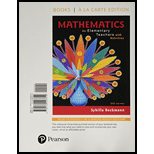
Make three different nets that could be cut out, folded, and taped to make an open-top 1-in.-by-1-in.-by-1-in. cube. To be nets, each square should be joined to another square along a whole edge of the square, notjust at a vertex. For two patterns to be considered different, you should not be able to match up the patterns when they are cut out. Download 8 has 1-in. graph paper you can use
Want to see the full answer?
Check out a sample textbook solution
Chapter 13 Solutions
Mathematics for Elementary Teachers with Activities, Books a la carte edition (5th Edition)
Additional Math Textbook Solutions
Precalculus: Mathematics for Calculus (Standalone Book)
University Calculus: Early Transcendentals (4th Edition)
Elementary Statistics: A Step By Step Approach
Calculus: Early Transcendentals (2nd Edition)
APPLIED STAT.IN BUS.+ECONOMICS
Finite Mathematics for Business, Economics, Life Sciences and Social Sciences
- Use the method of reduction of order to find a second solution to ty"-(4t+4)+(4t+8)y = 0, t> 0 Given y₁(t) = e²t Y2(t) = Give your answer in simplest form (ie no coefficients)arrow_forward1. Suppose the domain of discourse is kinds of minerals. Let A be kinds of minerals that dissolve in acid, let S be minerals that can be scratched by an iron nail, and let C be minerals that are clear. Write expressions using set operations that represent the following sets of minerals: (a) Minerals that dissolve in acid and can be scratched by an iron nail. (b) Minerals that dissolve in acid and are not clear. (c) Minerals that are either clear or both dissolve in acid but cannot be scratched by an iron nail. (d) Minerals that are neither dissolvable in acid nor scratable by an iron nail. (e) Minerals that are either both dissolvable in acid and scratchable by an iron nail or both dissolvable in acid and not clear.arrow_forwardExpress the integrand as a sum of partial fractions and evaluate the integral. 2 32s+ 32 (s²+1) (s-1)3 ds Express the integrand as a sum of partial fractions. (Simplify your answer.)arrow_forward
- Solve the problemarrow_forwardPerform long division on the integrand, write the proper fraction as a sum of partial fractions, and then evaluate the integral. 30x³-60x²+8 dx 2 x-2x After performing the long division, write the resulting proper fraction as a sum of partial fractions. Evaluate the integral. 30x³-60x²+8 2 x² -2x dx=arrow_forwardEvaluate the following integral. x/6 S tan 2x dx x/12arrow_forward
 Algebra: Structure And Method, Book 1AlgebraISBN:9780395977224Author:Richard G. Brown, Mary P. Dolciani, Robert H. Sorgenfrey, William L. ColePublisher:McDougal Littell
Algebra: Structure And Method, Book 1AlgebraISBN:9780395977224Author:Richard G. Brown, Mary P. Dolciani, Robert H. Sorgenfrey, William L. ColePublisher:McDougal Littell
